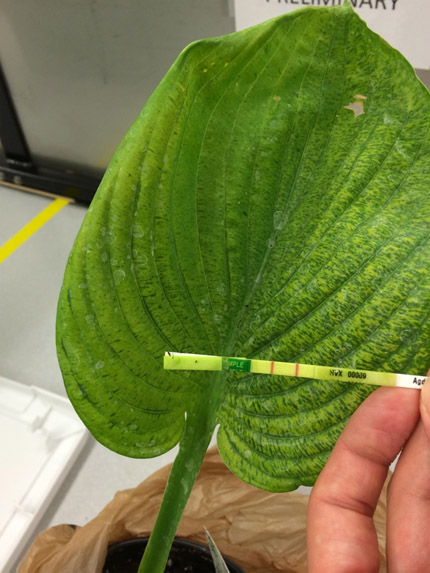Issue 10, July 5, 2017
Hosta Virus X
I am always looking for new and interesting hostas to add to my collection. However, whether I am shopping at a garden center, or offered a hosta from a neighbor's garden, I am always on the wary and on the lookout for Hosta Virus X (HVX. Unfortunately, symptoms of HVX can be quite difficult to recognize. To complicate things further, some infected plants may be asymptomatic, and not display indications of a HVX infection. As a result, that hosta you are looking to acquire may also be harboring HVX. Do not abandon your hosta collection. Rather, use caution when introducing new hostas to your garden.
As with most viral pathogens, HVX will not kill hosta; however it can cause a number of non-characteristic symptoms to appear on the host. Symptoms are usually consistent between plants of the same cultivar, but vary greatly between different cultivars. HVX often results in a change of leaf pigmentation to an either lighter or darker color. Color changes appear as mosaic, mottled, circular or "ink-bleed" (localized discoloration along the leaf veins) patterns. Other general HVX symptoms include: stunting, puckering, distortion, twisting, and necrosis. In general, avoid hosta's with features that vary significantly from those known to be normal for healthy plants of that cultivar. Not all HVX infected plants display symptoms. Infected plants may grow several years before displaying symptoms, while others never display symptoms at all. This means that seemingly healthy hostas growing near a HVX infected hosta may be infected as well.

Sum and Substance Hosta infected with Hosta Virus X. Confirmed using and ImmunoStrip. Note the darker pigmentation. A healthy, normal Sum and Substance leaf should be entirely light green.
HVX is transmitted from plant to plant through physical or mechanical means, especially during propagation. Fortunately, most reputable nurseries screen parent plants for pathogens prior to propagation. Secondary transmission occurs when HVX infected sap is transmitted to healthy, susceptible hosta by contaminated cutting tools and/or hands. The time of year may play a role in a plant's susceptibility to HVX. Some observations suggest HVX is most easily spread during spring months when hostas are actively growing and less likely to spread after bloom.
The following practices are recommended for Hosta Virus X management.
- Avoid introducing infected plants by purchasing from reputable sources.
- Avoid Spreading HVX within the landscape
- Transplant and divide hostas in the fall, or after they bloom.
- Clean and sanitize tools when working with hostas, especially as you move between plants.
- Have suspected HVX plants diagnosed by a plant diagnostic laboratory.
- No chemical treatments are available. HVX infected plants should be removed immediately and destroyed.
(Travis Cleveland)
Author:
Travis Cleveland